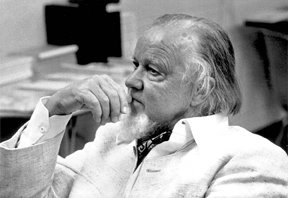Bringing Reality to the Spiritual Life (Part 1)
 Francis Schaeffer (1912-1984) was one of the most influential Christian thinkers of the 20th century. In 1955, he founded the L’Abri Fellowship, a residential community in Switzerland that allows visitors to stay for short or long periods of time, find answers to faith-related questions, and experience the Christian life being lived out firsthand.
Francis Schaeffer (1912-1984) was one of the most influential Christian thinkers of the 20th century. In 1955, he founded the L’Abri Fellowship, a residential community in Switzerland that allows visitors to stay for short or long periods of time, find answers to faith-related questions, and experience the Christian life being lived out firsthand.
Schaeffer studied under Reformed scholars Cornelius Van Til and J. Gresham Machen, and he developed strong convictions about biblical inerrancy and other doctrines upheld by conservative evangelicals. During the early 1950’s, however, Schaeffer experienced a personal spiritual crisis that led him to reexamine his faith. This crisis began when he honestly faced two problems he saw in Christian leaders who, like him, were strongly contending for biblical truth.
Divisions In The Church, Part II
 In my previous post, Why Do We Have Divisions?, I explained the apostle Paul’s contention that divisions occured in the church at Corinth because of unbiblical models of Christian leadership. According to Paul, a Christian leader has two primary roles:
In my previous post, Why Do We Have Divisions?, I explained the apostle Paul’s contention that divisions occured in the church at Corinth because of unbiblical models of Christian leadership. According to Paul, a Christian leader has two primary roles:
- He is a servant, not a boss (1 Cor 4:1; Mark 10:45).
- He is to proclaim the secret things of God (1 Cor 4:1), which is the gospel. Any direction and influence that he has must be effected through the preaching of the gospel of Jesus Christ, not by the exercise of political authority over the church or lording over others as non-Christian leaders do (Mark 10:42).
In the late 19th century, Charles Spurgeon identified these problems as being oppressive and detrimental to the church in England. In the 20th century, John Stott made similar observations in the church through out the world. Yes, God still worked, and he may continue to work in the midst of such problems. But if so, it is because of God’s grace alone, and the continued presence of God’s work does not justify divisive behavior.
Distinguishing Marks of a Work of the Spirit (Part 2)
 Continuing in the discussion of Distinguishing Marks of a Work of the Spirit of God by Jonathan Edwards, here are the five remaining “negative signs.” Remember: by calling them “negative signs,” Edwards is not saying that these marks prove that the Holy Spirit is not at work. He is saying that these signs do not conclusively prove or disprove that the Spirit is working. These signs may be present in a true movement of the Spirit, but they may also be found in counterfeit movements.
Continuing in the discussion of Distinguishing Marks of a Work of the Spirit of God by Jonathan Edwards, here are the five remaining “negative signs.” Remember: by calling them “negative signs,” Edwards is not saying that these marks prove that the Holy Spirit is not at work. He is saying that these signs do not conclusively prove or disprove that the Spirit is working. These signs may be present in a true movement of the Spirit, but they may also be found in counterfeit movements.
5. When people are stongly influenced by the personal example of others. Personal example plays an important role in human life and in all interactions among people whether or not the Spirit is moving. If many people begin to take action after being influenced by someone’s personal example, and if many people or many groups begin to exhibit similar thoughts and behaviors, it means nothing.
Navigating the Catholic-Protestant Split Today
 Editor’s note: This article was written and posted on another blog about one year ago. Given the discussions that have appeared on UBFriends in recent days, it seems like a good time to republish it.
Editor’s note: This article was written and posted on another blog about one year ago. Given the discussions that have appeared on UBFriends in recent days, it seems like a good time to republish it.
Reforming the Social Security program has often been called “the third rail of American politics” because if you touch it, you will get burned. The issues involved are so divisive, affecting individuals and families at such a personal level, that most national political leaders will avoid this subject at all costs.
Similarly, there is an electrified third rail in discussions about Christian unity. Being the naïve/pompous/foolish person that I am, I will now climb down onto the subway tracks, bend over, reach out, and grab this third rail with both hands.
What is this third rail? It is the centuries-old split between Protestants and the Roman Catholic Church.
Psychology Meets Religion (Part 2)
 Which would you rather have: Greater self control or higher intelligence?
Which would you rather have: Greater self control or higher intelligence?
There are obvious advantages to choosing intelligence. You would have an enhanced ability to apply your knowledge towards solving novel problems, be able to integrate multiple pieces of information and see clarity and order where others saw chaos. If you worked hard enough, you would definitely be able to secure a nice job for yourself and make good money.
A True Church Versus The True Church
 One the most significant trends in Christianity in the United States today is the proliferation of house churches. According to a recent Barna study, 10% of American adults worship in a house church in any given month. That statistic is truly stunning, given that estimates of weekly attendance across all churches range from 20% to 40%.
One the most significant trends in Christianity in the United States today is the proliferation of house churches. According to a recent Barna study, 10% of American adults worship in a house church in any given month. That statistic is truly stunning, given that estimates of weekly attendance across all churches range from 20% to 40%.
House churches are diverse and difficult to characterize. They tend to be small and informal, led by laypeople with no paid staff. They invoke simple, bare-bones Christianity without the trappings of organized religion. People seem to like them because they are the exact opposite of the megachurch, a symbol of what many find distasteful about present-day American culture. The megachurch is supposedly corporate, consumer-driven, and depersonalizing, whereas the house church is seen as authentic, organic, close-knit and personal, attractive to homeschoolers, do-it-yourselfers and others who like to swim against the prevailing tides. (Personally, I think that characterization of megachurches is unfair. But that’s another story.)
Distinguishing Marks of a Work of the Spirit (Part 1)
 Dear friends, do not believe every spirit, but test the spirits to see whether they are from God, because many false prophets have gone out into the world (1 John 4:1).
Dear friends, do not believe every spirit, but test the spirits to see whether they are from God, because many false prophets have gone out into the world (1 John 4:1).
Jonathan Edwards was a witness to and one of key figures in the Great Awakening (c. 1730-1745). During this great revival, the Holy Spirit came and worked in new and unexpected ways. This revival touched many lives and had many followers, but it had many strong opponents as well. The opponents pointed to unusual phenomena within this movement, claiming it was not the true work of the Spirit, and because of it questioned the validity of whole movement.

Last 30 Comments